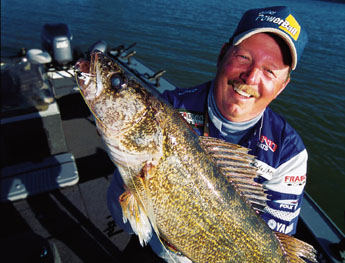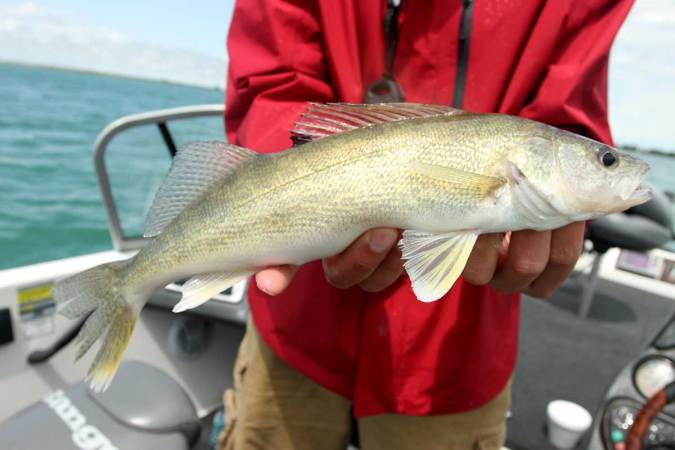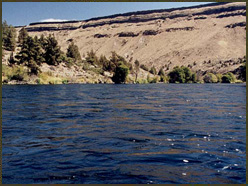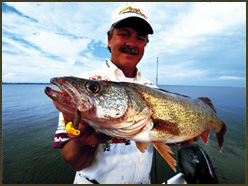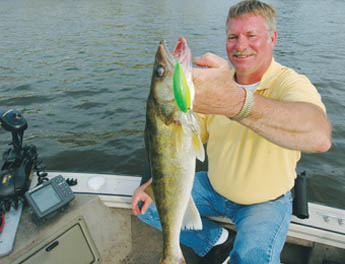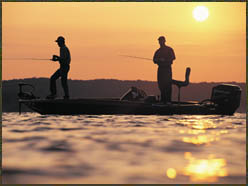Don’t be in a rush to put your walleye tackle into winter storage just yet. Sure, the fishing has been hit-or-miss lately-it always is when summer languishes before giving way to autumn. But some of the year’s best fishing for heavyweight walleyes lies just ahead. Stay with it a few more weeks and you won’t regret it. Walleyes are about to go on a feeding binge.
No fishermen are more attuned to the fall walleye blitz than tournament anglers who participate in annual championship events at season’s end. A championship victory is a career-maker, and these guys take the challenge seriously. They’ve tried every trick to put them in touch with big fall walleyes. They can tell the great techniques from the mediocre ones and have refined methods that will produce on your favorite walleye waters, from small rivers to the Great Lakes.
So, you can end your walleye season on a sour note or hang tough a little longer and finish with a high-five finale. If you decide to continue fishing, read on and learn about five hot fall tactics from noted walleye experts. One or more of these methods is sure to work for you.
1. Tapping the Last Green Weeds
When Grand Rapids, Minn., walleye pro Marty Glorvigen has trouble catching autumn walleyes, he turns things around by fishing green vegetation. This strategy has come through for Glorvigen and his identical twin Scott since they started learning their walleye ABC’s on Lake Winnibigoshish.
After the fall turnover, many species of aquatic vegetation die and deplete surrounding oxygen in the process, which causes fish to leave. But weed beds of mainly coontail or cabbage stay healthy until the cold kills them.
Baitfish flock to these last, isolated, green grass beds, and walleyes stay right on their tails. Glorvigen often finds walleyes around coontail in shallow bays 2 to 6 feet deep. “I typically start casting a one-eighth- to one- quarter-ounce Northland Weed Weasel jig to the outside edges of the coontail,” he says.
Glorvigen dresses the jig with a PowerBait or Gulp! grub and tips the hook with a minnow, a leech or a chunk of a crawler. He fishes the jig with a 7-foot medium-action rod with a fast tip and 30-pound-test Spiderwire line.
When Glorvigen starts picking up walleyes along one section of the weed edge, he slowly fishes his way into the grass by dipping a Northland Buck Shot Rattle Jig vertically into holes. Cabbage grass 12 to 18 feet deep also gives up autumn walleyes to Glorvigen. To locate it, use a depth finder.
[pagebreak] 2. Flashing ‘Eyes With Dipsy Divers
Jim Stedke of Wapakoneta, Ohio, catches Lake Erie walleyes averaging 6 to 10 pounds by trolling spoons behind diving planes for fish suspended over depths to 80 feet. Luhr Jensen’s Size 1 Dipsy Diver, which digs 30 to 65 feet deep, is Stedke’s workhorse.
When Stedke’s depth finder reveals big clouds of baitfish above scattered, active walleyes, he sets out as many as eight 8-foot 3-inch Dipsy rods in holders along the sides of his boat. The rods stick out horizontally.
“The holders are set at slightly different angles to keep the rods from banging into each other when a fish strikes,” says Stedke, who’s shown at left.
Dipsy rods, made by several manufacturers, feature soft tips for better strike detection and stout butt sections. Daiwa Line Counter trolling reels let Stedke set the divers back precise distances to reach productive depths.
Thin-diameter Power Pro Braided Spectra fiber line in 30- to 50-pound-test helps the Dipsies dive deeper than monofilament. Homemade 11-inch silicone snubbers between the Dipsies and 6-foot-long, 25-pound-test fluorocarbon leaders provide a cushion when battling walleyes and cut down on losses.
To prevent the lines from tangling and to create a wide trolling swath, Stedke dials in a different setting on each Dsy. The divers connected to the rods nearest the transom are set at 0 to make them track true. The Dipsies on the next rods up the gunwale are set on number 1 so they track off-center; the next Dipsies, set on number 2, track even farther off-center; and so on.
In the fall, Stedke trolls 3¾-inch Michigan Stinger spoons at about 2½ miles per hour to mimic large forage fish trying to escape from predators. His most productive color is “Superman,” which incorporates fluorescent blue, orange and chartreuse.
** 3. Dazzling Walleyes With Deep Spoons**
Baitfish form large, tight schools after the fall turnover, setting the table for walleyes on deep bottom structure. Walleye champion Mark Martin of Twin Lake, Mich., makes the most of a good thing with a jigging spoon.
Martin favors the ¾-ounce Hopkins Shorty and Swedish Pimple spoons. He ties a small ball-bearing swivel about 12 inches above a spoon to prevent line twist and connects 17-pound-test Trilene XT directly to a spoon with a cross-lock snap. The monofilament runs through the guides of a 7-foot medium-heavy-action Fenwick Techna AV spinning rod. The stiff rod is necessary to pop the spoon sharply off bottom and set the hook.
“I catch a lot of fall walleyes twenty to thirty feet deep, and I’ve spooned them as deep as fifty feet,” Martin says. “I look for them with my sonar on drop-offs, on rock piles, in transition zones between mud and sand bottoms, and in the mouths of rivers.”
Martin positions his boat on the deep side of the structure and casts his spoon up onto the high side of the drop-off. The instant the spoon hits the water, Martin closes the bail and takes up the slack. Then he holds the rod dead still at 1 o’clock and lets the spoon pendulum down. Many strikes occur on the initial drop.
[pagebreak] “When the line goes slack, the spoon has reached the bottom,” Martin says. “I always let the spoon rest for a moment because walleyes will pick it right up off the bottom.”
If a walleye doesn’t grab the spoon, Martin jumps it up 4 to 5 feet and lets it pendulum back to the bottom. He works the spoon all the way down the drop in this fashion, letting it rest for a few seconds each time it touches down. “Walleyes tend to follow a spoon,” Martin says. “Before I reel the bait up, I vertical-jig it several times. That’s a killer.”
** 4. Cranking Small Rivers**
The first thing Minnesotan Scott Glorvigen did after he won a walleye championship on Wisconsin’s Fox River was credit his victory to extensive fishing experience on trout and salmon rivers. He believes any fish in a river, regardless of the species, must conform to the dictates of the current.
“A fish is a fish is a fish in a river,” Glorvigen says. “You have to know how to read the water to find the eddies and current breaks where walleyes hold.”
Walleyes annually head up many rivers from lakes and reservoirs on a fall run that precedes the spring spawn. Glorvigen begins looking for such fish at the farthest obstructions upriver, such as dams and spillways that congregate baitfish and the walleyes that hunt them.
When walleyes feed in tailwater areas, they move to eddies and current breaks where they can snatch bait washing downstream to them. These feeding stations are often near the shoreline or midstream obstructions, such as rock piles.
In small rivers, say 50 to 100 yards wide, Glorvigen usually finds walleyes feeding in water 1 to 5 feet deep. He picks them off with a No. 5 firetiger Rapala Shad Rap cast upstream and retrieved across the current with a 7-foot medium-action Fenwick Techna AV spinning rod, 10-pound-test green Spiderline Super Mono and a Mitchell 300 reel.
[pagebreak] “I cast into six inches of water anywhere I see softer chutes and holes with small eddies that collect fish,” Glorvigen says. “Walleyes in the current have to make snap decisions, so I get a lot of reflex strikes.”
The Shad Rap also dupes walleyes when Glorvigen retrieves it over the upstream point that forms at the mouth of a river. The fish usually hold on the sharper drop on the downstream side of the upstream point. He holds his boat in the mouth of the tributary as he casts.
Eddies where a river narrows and bends can also be productive. One sweet spot is just upstream of an outside bend. Silt and sand settle there, creating a high spot where walleyes often feed along the current’s edge. Glorvigen tags the walleyes by casting upstream and retrieving the crankbait over the hump.
5. Trolling Drop-offs With Lead Lines
Walleye authority Gary Parsons of Glidden, Wis., claims that trolling lakes and reservoirs with leadcore line is a great way to catch big walleyes in the fall. He rarely fishes shallower than 30 feet, and sometimes trolls 50 feet deep.
Because leadcore line sinks, it pulls any crankbait, even a shallow runner, into the depths. This lets Parsons experiment with a variety of lures to determine exactly what walleyes prefer. Crankbaits of subtle action, such as Shad Raps, and short-lipped long minnowbaits generally do better in the fall. Parsons trolls no faster than 2 mph in autumn.
“Leadcore is a free-flowing weight system,” says Parsons, pictured at right with one of his trolling rigs. “Your bait usually dives a bit deeper than the line. Simply let out line until you feel the crankbait touching bottom.”
Parsons ties a 15-foot leader of 10-pound-test FireLine to 18-pound-test leadcore. This no-stretch combination lets him feel strikes and the bottom with ease. The line is teamed with an 8½-foot Walleye Angler trolling rod available from Bass Pro Shops.
Parsons recommends that anglers new to leadcore troll with no more than two rods to avoid tangles. He always holds one rod in his hand to monitor the bait’s bottom contact. He places the other rod in a holder. By using a depth finder along with his sense of feel, Parsons keeps his crankbaits walking precisely along the edges of deep drop-offs.
In October, he trolls for walleyes on deep structures close to their spring spawning areas. Walleyes sometimes suspend 20 to 50 feet away from drop-offs over deeper water. Parsons nabs these fish by using his GPS plotter to make parallel trolling passes just off the structure. He keeps his crankbaits running at the correct depth by maintaining the same line length and trolling speed.
“Leadcore lets you troll up and down a break effectively,” Parsons says. “As you troll down a drop-off, your baits will lose contact with the bottom. Then you just cut the throttle back and the leadcore walks that crankbait right down the breakline.”to make snap decisions, so I get a lot of reflex strikes.”
The Shad Rap also dupes walleyes when Glorvigen retrieves it over the upstream point that forms at the mouth of a river. The fish usually hold on the sharper drop on the downstream side of the upstream point. He holds his boat in the mouth of the tributary as he casts.
Eddies where a river narrows and bends can also be productive. One sweet spot is just upstream of an outside bend. Silt and sand settle there, creating a high spot where walleyes often feed along the current’s edge. Glorvigen tags the walleyes by casting upstream and retrieving the crankbait over the hump.
5. Trolling Drop-offs With Lead Lines
Walleye authority Gary Parsons of Glidden, Wis., claims that trolling lakes and reservoirs with leadcore line is a great way to catch big walleyes in the fall. He rarely fishes shallower than 30 feet, and sometimes trolls 50 feet deep.
Because leadcore line sinks, it pulls any crankbait, even a shallow runner, into the depths. This lets Parsons experiment with a variety of lures to determine exactly what walleyes prefer. Crankbaits of subtle action, such as Shad Raps, and short-lipped long minnowbaits generally do better in the fall. Parsons trolls no faster than 2 mph in autumn.
“Leadcore is a free-flowing weight system,” says Parsons, pictured at right with one of his trolling rigs. “Your bait usually dives a bit deeper than the line. Simply let out line until you feel the crankbait touching bottom.”
Parsons ties a 15-foot leader of 10-pound-test FireLine to 18-pound-test leadcore. This no-stretch combination lets him feel strikes and the bottom with ease. The line is teamed with an 8½-foot Walleye Angler trolling rod available from Bass Pro Shops.
Parsons recommends that anglers new to leadcore troll with no more than two rods to avoid tangles. He always holds one rod in his hand to monitor the bait’s bottom contact. He places the other rod in a holder. By using a depth finder along with his sense of feel, Parsons keeps his crankbaits walking precisely along the edges of deep drop-offs.
In October, he trolls for walleyes on deep structures close to their spring spawning areas. Walleyes sometimes suspend 20 to 50 feet away from drop-offs over deeper water. Parsons nabs these fish by using his GPS plotter to make parallel trolling passes just off the structure. He keeps his crankbaits running at the correct depth by maintaining the same line length and trolling speed.
“Leadcore lets you troll up and down a break effectively,” Parsons says. “As you troll down a drop-off, your baits will lose contact with the bottom. Then you just cut the throttle back and the leadcore walks that crankbait right down the breakline.”
